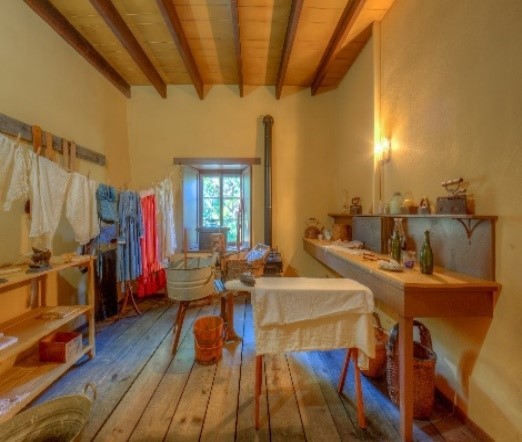RLC Adobe - The Laundry Room
Introduction
Text-to-speech Audio
When Flint, Bixby & Co. bought the property in 1866, Jotham & Margaret Bixby moved into the Temple adobe. By 1870, the Federal Census lists two Chinese domestic workers, Ah Ying and Ah Fan, at Rancho Los Cerritos. Their work was labor intensive, even though the factory-produced goods of the second industrial revolution were making some of the tasks easier than ever before. To do laundry, Ah Ying and Ah Fan first had to haul water from the well in the backyard, then heat it on a wood-burning stove before commencing with actual washing. They would certainly have appreciated this labor-sparing wringing apparatus that squeezed the soap out before the laundry was rinsed and then pressed out excess water before hanging the laundry to dry. The following day, the men ironed all the dried clothes, bed sheets, and table linens. Along the back wall is a small stove for heating irons. Sarah Bixby-Smith shares in Adobe Days (1925) how impressed she was with how Ah Ying would spray a mouthful of water on the cotton and woolen garments to have steam ironing.
Images
Laundry Room

Backstory and Context
Text-to-speech Audio
More than 20,000 Chinese immigrants came to California to strike it rich “on gold mountain,” but faced discrimination in the mines and were prejudicially subject to the Foreign Minors Tax (1852). As easier-to-find gold dwindled, many Chinese immigrants opted for domestic labor that otherwise went unfilled, while others chose the back-breaking amd dangerous labor of building the western portion of the Transcontinental Railroad (1863-1869). Over 10,000 Chinese laborers worked 12-hour days, 6 days a week, for $1/day to complete the 1,912-mile stretch to Utah. In the 1870s California, laws legally limited Chinese occupational choices.
